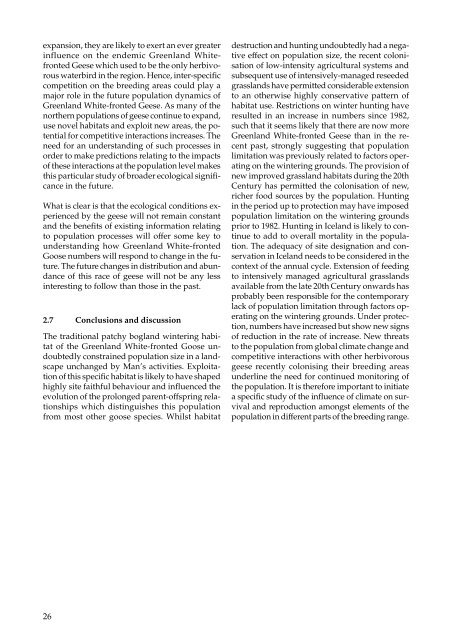The Greenland White-fronted Goose Anser albifrons flavirostris
The Greenland White-fronted Goose Anser albifrons flavirostris
The Greenland White-fronted Goose Anser albifrons flavirostris
Create successful ePaper yourself
Turn your PDF publications into a flip-book with our unique Google optimized e-Paper software.
expansion, they are likely to exert an ever greater<br />
influence on the endemic <strong>Greenland</strong> <strong>White</strong><strong>fronted</strong><br />
Geese which used to be the only herbivorous<br />
waterbird in the region. Hence, inter-specific<br />
competition on the breeding areas could play a<br />
major role in the future population dynamics of<br />
<strong>Greenland</strong> <strong>White</strong>-<strong>fronted</strong> Geese. As many of the<br />
northern populations of geese continue to expand,<br />
use novel habitats and exploit new areas, the potential<br />
for competitive interactions increases. <strong>The</strong><br />
need for an understanding of such processes in<br />
order to make predictions relating to the impacts<br />
of these interactions at the population level makes<br />
this particular study of broader ecological significance<br />
in the future.<br />
What is clear is that the ecological conditions experienced<br />
by the geese will not remain constant<br />
and the benefits of existing information relating<br />
to population processes will offer some key to<br />
understanding how <strong>Greenland</strong> <strong>White</strong>-<strong>fronted</strong><br />
<strong>Goose</strong> numbers will respond to change in the future.<br />
<strong>The</strong> future changes in distribution and abundance<br />
of this race of geese will not be any less<br />
interesting to follow than those in the past.<br />
2.7 Conclusions and discussion<br />
<strong>The</strong> traditional patchy bogland wintering habitat<br />
of the <strong>Greenland</strong> <strong>White</strong>-<strong>fronted</strong> <strong>Goose</strong> undoubtedly<br />
constrained population size in a landscape<br />
unchanged by Man’s activities. Exploitation<br />
of this specific habitat is likely to have shaped<br />
highly site faithful behaviour and influenced the<br />
evolution of the prolonged parent-offspring relationships<br />
which distinguishes this population<br />
from most other goose species. Whilst habitat<br />
26<br />
destruction and hunting undoubtedly had a negative<br />
effect on population size, the recent colonisation<br />
of low-intensity agricultural systems and<br />
subsequent use of intensively-managed reseeded<br />
grasslands have permitted considerable extension<br />
to an otherwise highly conservative pattern of<br />
habitat use. Restrictions on winter hunting have<br />
resulted in an increase in numbers since 1982,<br />
such that it seems likely that there are now more<br />
<strong>Greenland</strong> <strong>White</strong>-<strong>fronted</strong> Geese than in the recent<br />
past, strongly suggesting that population<br />
limitation was previously related to factors operating<br />
on the wintering grounds. <strong>The</strong> provision of<br />
new improved grassland habitats during the 20th<br />
Century has permitted the colonisation of new,<br />
richer food sources by the population. Hunting<br />
in the period up to protection may have imposed<br />
population limitation on the wintering grounds<br />
prior to 1982. Hunting in Iceland is likely to continue<br />
to add to overall mortality in the population.<br />
<strong>The</strong> adequacy of site designation and conservation<br />
in Iceland needs to be considered in the<br />
context of the annual cycle. Extension of feeding<br />
to intensively managed agricultural grasslands<br />
available from the late 20th Century onwards has<br />
probably been responsible for the contemporary<br />
lack of population limitation through factors operating<br />
on the wintering grounds. Under protection,<br />
numbers have increased but show new signs<br />
of reduction in the rate of increase. New threats<br />
to the population from global climate change and<br />
competitive interactions with other herbivorous<br />
geese recently colonising their breeding areas<br />
underline the need for continued monitoring of<br />
the population. It is therefore important to initiate<br />
a specific study of the influence of climate on survival<br />
and reproduction amongst elements of the<br />
population in different parts of the breeding range.


